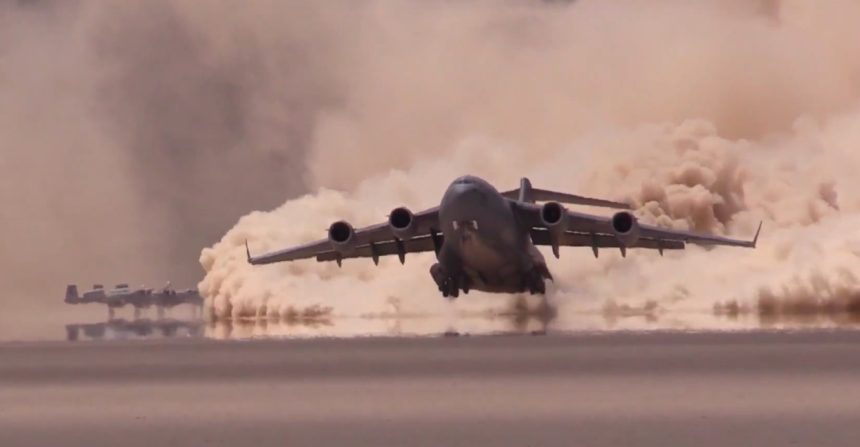U.S. Air Force landed and took off from the Delamar Dry Lake Bed, the emergency landing site for the X-15.
C-17 Globemaster III airlifters from 57th Weapons Squadron, A-10 Thunderbolt IIs from the 66th Weapons Squadron, HC-130J from the 34th Weapons Squadron as well as HH-60Gs belonging to the 66th Rescue Squadron took part in USAF Weapons School squadrons composite mission application and combat search and rescue operations at the Delamar dry lake bed on the NTTR (Nevada Test and Training Range).
Referred to as “Texas Lake” dry lake bed because of its resemblance to the state of Texas from the air, Delamar Lake landing strip was established in 1943 and, in the 1960s it was designated emergency landing site for the North American X-15, a rocket-powered, missile-shaped manned aircraft operated by the U.S. Air Force and NASA capable to reach the edge of space at an altitude between 100,000 and 300,000 feet at speed exceeding 4,500 MPH (+7,270 km/h).
In fact, the dry lake bed was located underneath the Delamar Dry Lake Drop Zone where the X-15s brought to the launch altitude of 45,000 feet under the wing of a B-52 bomber, were dropped at a speed of Mach 0.8.
The Delamar Lake Landing Strip consists of a 15,000 ft long runway; still, considered the lack of obstacles, aircraft can land in any direction.
Along with making “unprepared landing strip operations” training possible, dry lakes can be particularly useful also in case of emergency: the huge lakebed can minimize the damage to a plane forced to land there. Here is what happened when a B-1 Lancer performed a crash landing on the Rogers Dry Lake at Edwards Air Force Base in 1989. Here you can find a U.S. Air Force C-5 Galaxy airlifter making a successful emergency landing once again at Rogers Dry Lake in 2001.
Update: We have received an interesting email from Paul Raveling, from sierrafoot.org who provided more details about Delamar:
“Delamar Dry Lake was not the first/original dry lake designated for X-15 emergency landing. The first was Rogers, the NB-52A carrier did a spiral climb to keep the X-15 within gliding range for an emergency landing at all times until another uprange dry lake was in gliding range for the X-15. Delamar was used later in the program, notably as the launch dry lake for Bob White’s FAI world altitude record flight (314,750 feet). If my recollection is in gear, a total of 11 dry lakes were used as emergency landing sites for the X-15 program.
My recollection of the count of 11 is a bit hazy now. Groom was an “interesting” case, two NASA pilots discovered it by accident during the time only the USAF X-15 pilots were told it existed. I kept a mildly amusing email from Neil about how Jack McKay and Forrest Petersen discovered it while roaming around the desert in the NASA R4D.
Most X-15 flights had two or three dry lakes planned for emergency landings, up fo for if you count Rogers. On the morning of an X-15 flight the Air Force flew a crew to each, with gear including a full-sized fire truck. C-130s were the transport for these. Dry Lake locations also determined the number of chase planes used, to assure chase coverage for emergency landings anywhere on course.”









